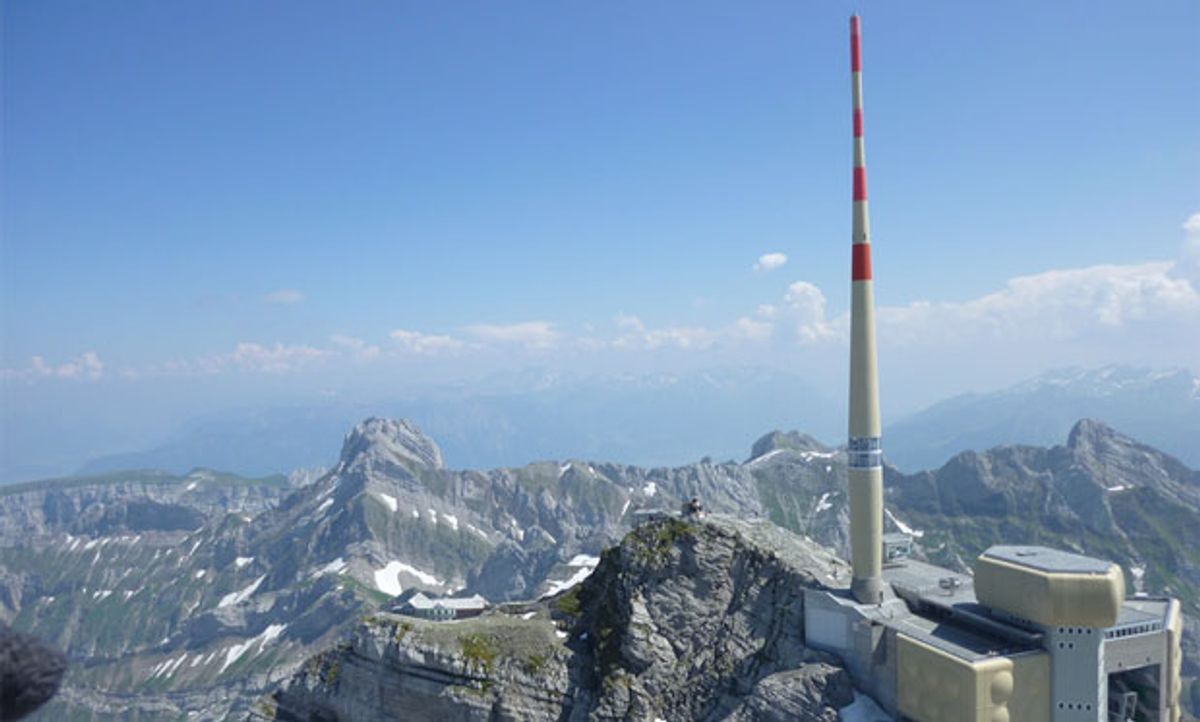Atop a rocky peak in the Swiss Alps sits a telecommunications tower that gets struck by lightning more than 100 times a year, making it perhaps the world’s most frequently struck object. Taking note of the remarkable consistency with which lightning hits this 124-meter structure, researchers have adorned it with instruments for a front-row view of these violent electric discharges.

On Wednesday, a small team installed a new gadget near Säntis Tower in their years-long quest to better understand how lightning forms and why it behaves the way it does. About two kilometers from the tower, they set up a broadband interferometer that one member, Mark Stanley of New Mexico Tech, had built back in his lab near Jemez, New Mexico.
“You can’t really go to a company and find an instrument that’s built just for studying lightning,” says Bill Rison, Stanley’s collaborator who teaches electrical engineering at New Mexico Tech. “You have to build your own.”
The one Stanley built has three antennas with bandwidth from 20 to 80 megahertz (MHz) to record powerful electromagnetic pulses in the very high-frequency range that lightning is known to produce. The device also has a fourth antenna to measure sferics, which are low-frequency signals that result from the movement of charge that occurs with a strike or from storm activity within clouds. “Basically, lightning is a giant spark,” Rison explains. “Sparks give off radio waves and the interferometer detects the radio waves.”
To anyone who has witnessed a lightning strike, everything seems to happen all at once. But Stanley’s sensor captures several gigabytes of data about the many separate pulses that occur within each flash. Those data can be made into a video that replays, microsecond by microsecond, how “channels” of lightning form in the clouds.
Video: William Rison of New Mexico Tech
By mapping lightning in this way, the Säntis team, which hired Stanley and Rison to haul their interferometer to Switzerland, hopes to better understand what prompts lightning’s “initiation”—that mysterious moment when it cracks into existence.
So far, measurements have raised more questions than they’ve answered. One sticking point is, in order for a thunderstorm to emit a lightning strike, the electric field within it must build to an intensity on the order of several megavolts per meter. But while researchers have sent balloons into thunderstorms, no one has measured a field beyond 200 kilovolts per meter, or one-tenth of the required value, says Farhad Rachidi of the Swiss Federal Institute of Technology (EPFL), who co-leads the Säntis research team.
“The conditions required for lightning to be started within the clouds never seem to exist based on the measurements made in the clouds,” says Marcos Rubinstein, a telecommunications professor at Switzerland’s School of Business and Engineering Vaud and co-leader of the Säntis team with Rachidi. “This is a big, big question.”
In his own research at New Mexico Tech, Rison has laid some groundwork that could explain how small electric fields can produce such big sparks. In 2016, he and his colleagues published a paper in NatureCommunications that described experimental evidence showing that a process known as fast positive breakdown can create a series of streamers, or tiny sparks, and may arise from much stronger local electric fields that occur in small pockets within a storm.

If enough streamers occur in quick succession and within close vicinity to one another, they make more streamers, adding up to a streamer “avalanche” that turns into positive leaders, or mini-bolts that branch toward clouds or the ground.
“We haven’t hit any roadblocks yet to say, this is something that isn’t the process for the initiation of lightning,” Rison says. With his evidence in hand, theorists are now trying to explain exactly how and why these fast positive breakdowns occur in the first place.
Meanwhile, the Säntis team wants to adapt a mathematical technique called time-reversal, which was originally pioneered for acoustics, to better understand lightning’s initiation. With this method, they intend to use data gathered by the tower’s many instruments (which include a collection of six antennas called a lightning mapping array, two Rogowski coils to measure current, two B-Dot sensors to measure the current time-derivative, broadband electric and magnetic field sensors, and a high-speed camera) to reconstruct the total path of strikes soon after they happen, tracing the electromagnetic radiation all the way back to its original source.
As has been true of past lightning research, their findings may someday inform the design of airplanes or electric grids, and help protect people and equipment against lightning strikes and other sudden power surges. The Säntis team’s work has held particular relevance for wind farm operators. That’s because most strikes recorded at the tower are examples of upward lightning—which travels from ground-to-cloud instead of cloud-to-ground.
Video: Farhad Rachidi and Marcos Rubinstein
Upward lightning often originates from tall buildings and structures, which can actually create a lightning bolt that shoots skyward, and this process can damage wind turbines. In 2013, the team published one of the most extensive descriptions to date of this type of flash.
More recently, their work has raised questions about why industry safety certifications for aircraft are based on data about downward strikes, instead of upward ones, which commonly occur with aircraft and cause particular kinds of damage that look more like lightning damage reported by pilots and mechanics.

By the end of this year, the Säntis team expects to record its 1,000th lightning strike at the tower. And there’s one more elusive scientific matter with massive practical implications they hope to someday resolve. “If we understand how lightning is initiated, we could take a big step forward on one of the other questions we’ve been trying to solve for a long time, and that’s to be able to predict lightning before it happens,” says Rubinstein.



